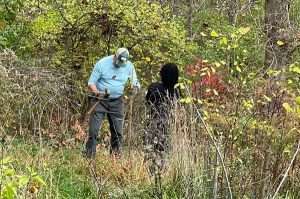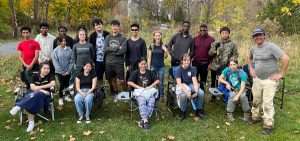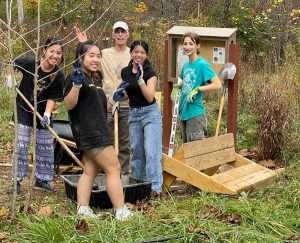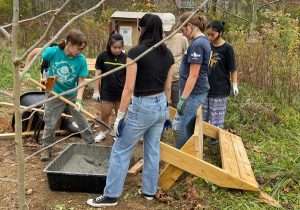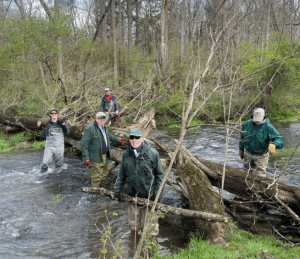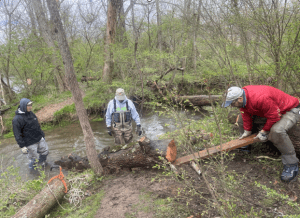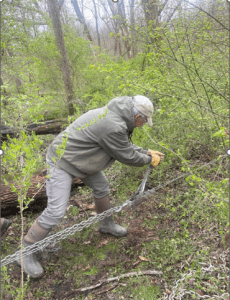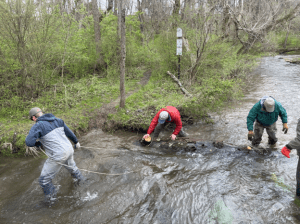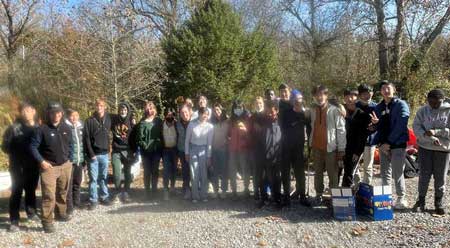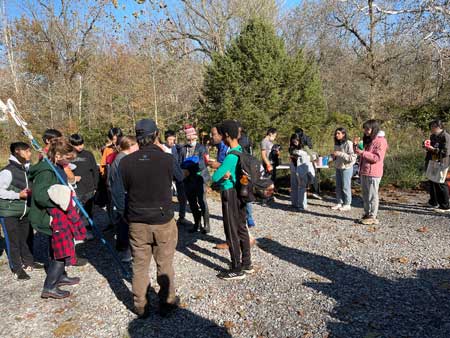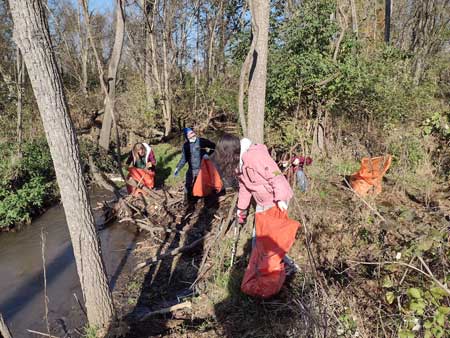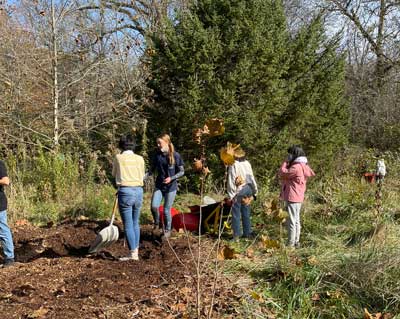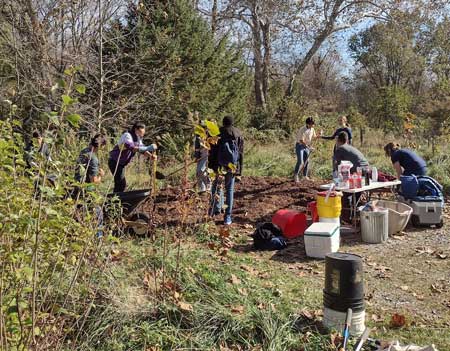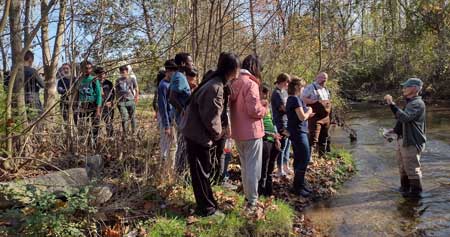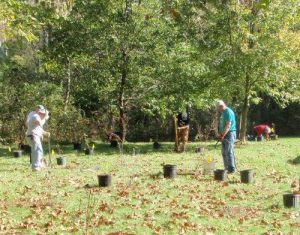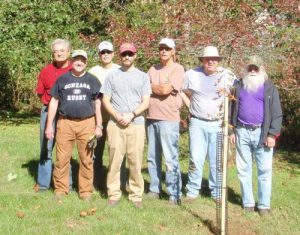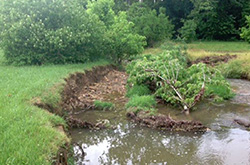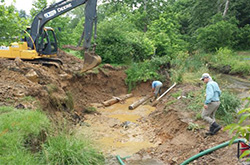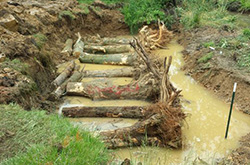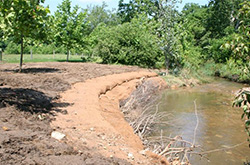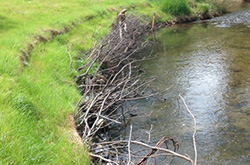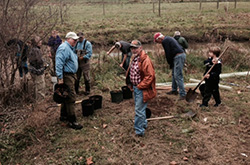SVTU Participates With Beaver Creek Projects
Restoration Projects
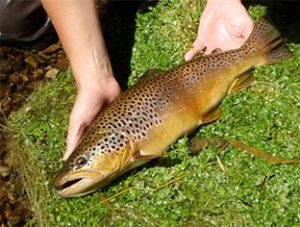
Beaver Creek is one of the largest limestone streams in Maryland. Originating as a freestone stream on the west slope of South Mountain, the majority of the flow during the summer months is influenced by the numerous springs in the Hagerstown Valley. The largest spring (~11,356 l/min) influencing Beaver Creek is used as the water supply for the Albert Powell Trout Hatchery. Upstream of the spring’s influence, Beaver Creek is considered a warm-water stream and flows underground much of the year due to local Karst geology.
In January 2004, approximately one mile of Beaver Creek—formerly under the control of the Antietam Fly Anglers—was established as a catch-and-return fly-fishing-only area open to the public. This area extends from the mouth of Black Rock Creek (downstream) to the upper boundary of the Perini property, approximately 161m above Beaver Creek Road. The special regulation area is entirely on private property. This area is now managed for wild trout due to favorable year-round water temperatures and some natural reproduction of brown trout.
In August there was a devastating fish-kill on Beaver Creek. We lost a large population of our large adult trout and it has set us back several years. You can learn more at the end of the page.
SVTU Contributes to Beaver Creek Projects
Starting in 2004, SVTU has been actively involved in helping with the Beaver Creek restoration project. During this time our chapter has purchased trees, provided funds and volunteered hours of labor to help with the restoration efforts.
Annual Beaver Creek Workday
Saturday, November 18
On November 18, SVTU members cleaned up a section of the trails along Beaver Creek. We worked all day in the area below Black Rock Creek and above the bridge on Beaver Creek Church Road. We removed dead limbs from the August storm, widened the trail, and removed some of the nastiest multi-floral rose thickets in this section. We rented a chipper (thanks to Rentals Unlimited for the discount!) and reduced a huge pile of “debris” to a soil conditioner. Thanks to SVTU members John Smith, Bob Hickey, Tom Hebert, Tim Schuler, Doug Hutzell, and Noel Golllehon, along with a hard-working student from the St. James school, Jordan Hughes. Together we made a big improvement in the trails.
Beaver Creek Workday on DNR Property
Saturday, November 4
On November 4, SVTU members were among a group that removed and picked-up tree tubes on a tract owned by the Department of Natural Resources (DNR) just upstream of the Albert Powell Fish Hatchery on Beaver Creek. DNR acquired the property and is converting it into woodlands to protect and filter the water flowing into Beaver Creek.
The trees that survived have grown and were splitting the protective tree tubes. Where the trees did not survive the tubes were on the ground. The crew picked up and pulled out a pickup load of old tree tubes but came nowhere close to finishing the task. The clean-up crew were members of Seneca Valley TU, Beaver Creek Watershed Association, Antietam-Conococheague Watershed Alliance, the Sierra Club and interested individuals. There will likely be another workday in December, so look for a notice via SVTU e-mail.
Annual Beaver Creek Workday
Saturday, November 5, 2022
Once again, on the first Saturday in November, volunteers were mustered to Beaver Creek, to conduct streamside maintenance. With great weather, the nine members from Seneca Valley TU Chapter and Beaver Creek Watershed Association along with 18 students from St. James High School were ready to tackle the day’s tasks. Tree guards were removed, and trees along the stream trail pruned. Wire around some trees was removed. Wire cages were installed around shrubs to try and prevent deer damage and around some trees due to the discovery of recent beaver damage. Old livestock fencing was removed, trash picked-up along Black Rock & Beaver Creeks, and recently installed benches secured. The benches were part of an Engle Scout project built by Jesse Mangalapati. Lunch was a highlight of the day with sub sandwiches, homemade chili and apple crisp.
Enthusiasm continued in the afternoon to complete the remaining work. A few diehard volunteers stayed afterwards for a nice cold beverage and to critique the day’s work. All and all it was a great day and SVTU and the Beaver Creek Watershed Association would like to thank everyone who attended, for a job well done.
- A SVTU volunteer, assisted by a St. James student are putting tree cages around shrubs
- St. James students who helped with the workday on Beaver Creek
- Learning how to mix concrete
- Female students from St. James school are mixing concrete and placing it in a hole they dug
Spring Beaver Creek Workday
Saturday April 9, 2022
SVTU received permission from DNR to remove a couple of trees across Beaver Creek, just upstream of the area where the Chapter assists with tree plantings and maintenance. While wood in the water often improves fish habitat, that was not the case with these trees that spanned the creek just above the water level. If a person wading was caught under these trees the outcome could be catastrophic. For safety reasons it was decided to remove them.
A group of six from SVTU and Antietam Fly Anglers met on the stream on April 9 to remove the trees. This was HEAVY work. First, we safely used chain saws to cut the trees into sections. Next, we floated (pulled and pushed) the logs to calm water near a bank. Finally, we used chains and a come-along and boards for a temporary ramp to pull the logs out of the stream onto the bank. We got it done with what we had, but it was hard work. It was also very satisfying to see that wading hazard removed and the job accomplished with no injury except a few sore muscles.
- Cleaning off the small limbs to gain access for the chain saws
- A temporary ramp helps the very wet tree trunk slide up and out of the creek
- The pulling power comes from the guy working the come-along anchored to a nearby tree
- It took a lot of manpower to position the logs so they could be removed
Seneca Valley TU (SVTU) sponsored a workday on Beaver Creek on Saturday, November 6, 2021. We had a glorious day with a fantastic turnout that combined for a very productive day.
We had crews working on:
- Trash patrol, covering 2.5 miles of stream on Black Rock and Beaver Creek and collecting 10 bags of trash
- Pruning overgrown fishing and walking trails
- Doing tree maintenance (pruning limbs, removing and installing protection from beavers and deer)
- Maintaining recently-planted shrubs and trees near the parking lot by clearing away the grass, as well as mulching and fertilizing
The reason we were able to accomplish so much was the enthusiastic support from students at Saint James School in Hagerstown. This Episcopal boarding school participated with over 30 students who worked very hard and enabled much to be accomplished to help maintain Beaver Creek. Those students were assisted by 15 volunteers from SVTU, Beaver Creek Watershed Association, Antietam-Conococheague Watershed Alliance, and Antietam Fly Anglers, who both guided the students, staffed the work crews and worked on cleaning up invasives, pruning trees and checking tree guards.
Lunch was provided by the Beaver Creek Watershed Association and SVTU, with a real boost from the big pot of chili provided by Anna Hutzell. It was a fantastic effort and much was accomplished! The trail by Beaver Creek is now walkable because of the hard work of everyone.
- Group Photo of St. James Student Volunteers
- Students getting work assignments
- Picking up trash
- Working on the mulch pile
- Hauling mulch
- Students learning about Beaver Creek
On Saturday November 7, SVTU had an annual stream workday. It was a good turn out with volunteers from neighboring chapters and watershed organizations. Everyone was tooled up and ready to tackle the work of removing tree guards, pruning trees and reinstalling wire around the trees to protect them from beavers. Regulation signs were replaced with some repair work to existing DNR sign. By lunch time (provided by Beaver Creek Watershed Association) most of the work was completed on the lower section of the catch & release area. But the enthusiasm continued, about six volunteers drove over to the Fly Fishing parking lot and continued working, trimming lower tree limbs, removing tree guards and checking on wire tree cages. A few diehard volunteers ended up on my patio for a nice cold beverage. All and all it was a great day. I would like to thank everyone who attended.
Beaver Creek Work Day
On October 21, 2017, Seneca Valley TU & Antietam Fly Anglers planted screening plants for the future parking lot on Beaver Creek in the new Charles Jackson Fish Management Area. The volunteers made sure tree protection was in place, and did general maintenance (cleaning up invasive plants) in past planting areas. Even though the weather was very warm for October, everyone had a fun day!
- Planting Trees
- Hot and tired volunteeers
Project Maintenance November 26, 2016
It is not enough to plant riparian buffer areas and then walk away, they take maintenance too. On Saturday, November 26, 2016, SVTU volunteers gathered along Beaver Creek to spend the morning on maintaining the plantings in the stream restoration areas that SVTU helped install. The five volunteers hacked at invasives, pruned branches, removed tree guards, installed tree guards, widened trails, and generally cleaned up the area. We found little actual trash thanks to the conservation ethos of fly fisherman, but there was a lot of vegetative “trash” to clear. It was a good time on a beautiful day and only one volunteer found the nearby electric fence.
Little Beaver Creek Planting Nov 7, 2015
On Saturday, November 7, 2015, eleven SVTU members and friends planted a project area along Little Beaver Creek in Washington County. This was a project will improve water quality on Little Beaver Creek, Beaver Creek, Antietam Creek, and ultimately the Potomac River and Chesapeake Bay. SVTU was one of the sponsors of this stream bank restoration project and the planting was the final step in this project. We planted about 100 trees and shrubs to anchor the bank after the construction of a root wad stabilized bend to address a bank erosion issue. Thanks to the members and friends of SVTU that came out and did their part for water quality.
- Little Beaver Creek before construction begins
- Excavation starts
- Root wads have been set
- Construction has is finished, time for seeding
- Seeded and grass is up
- Volunteers start planting trees and shrubs
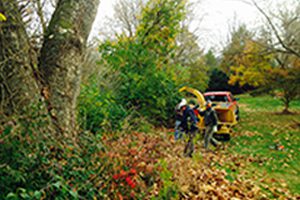
On November 8, 2014, 14 volunteers spent about five hours each on a beautiful day doing maintenance activities in the Beaver Creek project areas. Eight of the volunteers were from SVTU—the largest group represented. We installed beaver guards on trees, did a lot of tree-trimming and pruning and removed invasive vegetation. We broke for lunch with hot chili and beans. It was a good day to be out! One of the tasks was cleaning up storm damage from the summer, including chipping a fallen tree to allow stream access.
In October 2010, 40 members and friends of Seneca Valley TU came together with about 600 potted trees and shrubs in a newly restored area of Beaver Creek in Washington County. At the end of the day, the vast majority of the trees and shrubs were planted into predetermined locations along the streambanks. The October planting (and the follow-up work) culminated almost a year of activity on the part of SVTU to secure adequate funding, and to plan and implement the planting. Working with many partners, including the Beaver Creek Watershed Association, SVTU completed the last element of a restoration project by assuming responsibility for the re-vegetation after others completed the instream work.
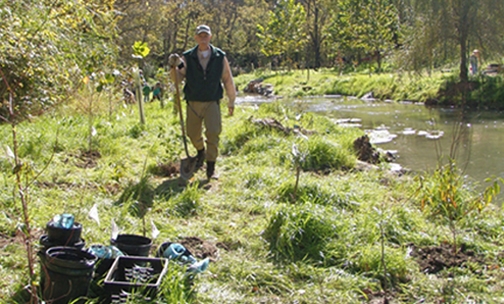
The almost 1.5 acres of riparian area replanted in this effort was the final stage in an over $100,000 restoration of about 850 feet in the fly-fishing only portion of Beaver Creek. The project implemented a Natural Channel Steam Design to correct the width and depth of the stream. A series of riffle, run, pool, and glide configurations were constructed to enhance the stability of the stream and to provide fish habitat. This was accomplished by installing rock/log crossvanes and J-hooks, boulder clusters, and scour logs. These changes will provide increased sediment transport, lower water temperatures, and provide an area for higher flows to over-top and relieve some of the channel velocity.
Banks and low-flow benches were stabilized with coirmatting, and annual rye and native grasses. The SVTU-led effort to plant the 600 native trees and shrubs contributed to the bank stabilization and addition of a riparian buffer. The revegetation phase of the 2010 stream improvement projects is the latest in a series of Beaver Creek improvements that began in 2003. SVTU has been involved in efforts on three stream segments prior to the 2010 effort. Prior efforts have included providing funding, volunteer labor, project support, and maintenance of planted areas.
2005
Seneca Valley TU (SVTU) purchased large trees and organized the planting of purchased and donated trees and shrubs along the Catch-and-Release area of Beaver Creek in Washington County. The plantings, conducted on November 13, 2004 and April 9, 2005, were the major effort associated with a National TU Embrace-a-Stream Grant received by SVTU for this project.
On November 13, 2004, over 40 volunteers planted trees along Beaver Creek in the area disturbed by the restoration project in the catch-and-release waters. We started the day with 100 purchased and donated trees and shrubs and managed to get most of them planted before lunch, despite the wet conditions and the on-going construction. The 40 purchased trees are all native to the area and include Red Maple, River Birch, Green Ash, Black Gum, Swamp White Oak, Serviceberry, and Redbuds. The trees were purchased by Seneca Valley TU with funds provided by a National TU Embrace-A-Stream Grant, Chapter resources, and the Mid-Atlantic Council of TU.
The beaver Creek Watershed Association furnished a great hot lunch on the stream. The construction company finally completed the stream work and released the water back into the main channel on November 22, 2004. Eleven volunteers returned on the day after Thanksgiving November 26, to plant in the areas vacated by the in-stream construction. We planted all the remaining trees, except two that will be planted after the construction crew cleans up and vacates the site.
Seneca Valley’s contribution is a part of a $200,000 stream restoration effort headed by the Beaver Creek Watershed Association and the Washington County Soil Conservation District. We are planting larger trees in the distributed area to restore the site as quickly as possible. We can look forward to another planting in the spring because construction delays will prevent us from covering all the area this year. If you have not seen the project, it is very impressive and has significantly improved the trout habitat in the upper section of the Beaver Creek catch-and-release area. The project will perform as designed after a couple of high flow events to flush the sediment out of the gravel and start the movement of the bed load. Also, a high flow will allow the water that is currently backed up in the channel by a new sandbar to readjust to create the pool-to-riffle effect.
My personal thanks to everyone who came out to help with the planting and support Seneca Valley’s role in this restoration effort. In addition to Seneca Valley TU members, planters came from the National Capital, Potomac-Patuxent, and Northern Virginia Chapters of TU, Antietam Fly Anglers, and the Beaver Creek Watershed Association. Thanks to all!
2004
On a beautiful spring morning in early April, about ten Chapter members and two Beaver Creek residents (Anna Hutzell and one of her neighbors) planted a dozen trees and about 40-50 bushes along the creek. Most of the planting was in the area just southeast of the bridge, where the contractor's heavy equipment prevented us from planting last fall.
The trees were purchased by the Chapter, as part of our commitment to improving the watershed, and were the last of more than 50 that the Chapter has planted since the contractor completed work on the streambed.
Digging the holes for the trees and bushes was made easier by the heavy rains earlier in the week; however, the numerous rocks in the soil hindered progress in many cases. In addition to the planting effort, several volunteers assisted with freeing a fairly large water snake from the netting placed along the creek edge to hold the soil while the grass grew back. Once freed, the snake slithered into the creek and swam off downstream, without even offering any thanks to his rescuers.
Devastating Fish Kill on Beaver Creek
On Monday, August 7, a heavy thunderstorm with lighting, high winds, and hail moved through the Beaver Creek area, east of Hagerstown. The storm deposited a tree in the Creek and dropped 2.5 inches of rain. The next day, a fisherman and Maryland Department of Natural Resources (DNR) staff, who coincidentally happened to be at the stream, started reporting dead adult brown trout. As the day progressed, it became clear that there was a devastating fish kill that basically wiped out the adult brown trout population in the fly fishing only section of Beaver Creek. There were many dead fish, from 4 to 22 inches found, but most would have been washed downstream in the high water following the heavy rain, so it is unknown how many fish remain and how many perished.
As of Wednesday, DNR and Maryland Department of the Environment (MDE) are investigating the cause of the fish kill. We do not know much at this time, but we do know that temperature monitors in the stream do not indicate a temperature spike as the cause.
Fish and water samples are being sent to laboratories for a more complete analysis, and hopefully the tests will confirm a cause. We do not know if this was a surge of something and the water is now fine or if the storm washed a persistent pollutant into the stream that would affect fish health for weeks, months, or even years.
DNR did a macroinvertebrate sampling on Tuesday and found that the bugs seem to be OK at first glance. They also found some sculpins and minnows alive in the impact area. They also did some spot checking and found adult brown trout in Black Rock Creek, in the hatchery discharge channel above the confluence with Beaver Creek, and downstream in Beaver Creek below the Mill and Beaver Creek Road.
Whatever the pollutant was it came into the main channel of Beaver Creek somewhere upstream of the fly-fishing only area and wiped out the adult brown trout. The pollutant was then diluted to the point that fish below the Route 40 bridge survived. It is unknown how much further upstream fish may have survived.
DNR has completed their investigation into the fish kill and you can get the PDF of the investigation below.
The Seneca Valley Chapter of Trout Unlimited (SVTU) is a local voice of National Trout Unlimited.
SVTU is a 501(C)3 organization, so your cash contributions are tax deductible to the level allowed by your tax situation. Direct contributions are always appreciated, and we will occasionally solicit with a direct campaign to fund a special project from time to time. You can easily donate to our chapter, just click the donate button. Thanks!
© Seneca Valley Trout Unlimited, Chapter 369

